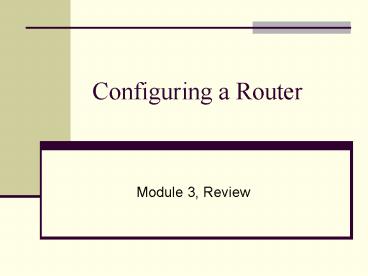Configuring a Router PowerPoint PPT Presentation
1 / 21
Title: Configuring a Router
1
Configuring a Router
- Module 3, Review
2
3.1.1 CLI command modes
3
3.1.2 Configuring a router name
- This task is accomplished in global configuration
mode with the following command - Router(config)hostname Tokyo Tokyo(config)
4
3.1.3 Configuring router passwords
- This command is used to encrypt passwords in
configuration output - Router(config)service password-encryption
- The service password-encryption command applies a
weak encryption to all unencrypted passwords. - The enable secret ltpassword gt command uses a
strong MD5 algorithm for encryption.
5
3.1.3 Configuring router passwords
- The enable password and enable secret commands
are used to restrict access to the privileged
EXEC mode. - Passwords should always be configured for virtual
terminal (vty) lines and the console line.
6
3.1.3 Configuring router passwords
- The following commands are used to set a password
on vty lines - Router(config)line vty 0 4
- Router(config-line)login
- Router(config-line)password ltpassword gt
7
3.1.4 Examining the show commands
- show flash - Displays information about flash
memory and what IOS files are stored there - show version - Displays information about the
currently loaded software version along with
hardware and device information. - show startup-config - Displays the saved
configuration located in NVRAM
8
3.1.5 Configuring a serial interface
- Configure the IP address with the following
commands - Router(config)interface serial 0/0
- Router(config-if)ip address ltip address gt
ltnetmask gt - The commands that are used to set a clock rate
and enable a serial interface are as follows - Router(config)interface serial 0/0
- Router(config-if)clock rate 56000
- Router(config-if)no shutdown
9
3.1.5 Configuring a serial interface
- By default, Cisco routers are DTE devices but
they can be configured as DCE devices. - On serial links that are directly interconnected
one side must be considered a DCE and provide a
clocking signal. The clock is enabled and speed
is specified with the clock rate command. - By default, interfaces are turned off, or
disabled. - Each connected serial interface must have an IP
address and subnet mask to route IP packets. By
default interfaces have no ip address on them.
10
3.1.5 Configuring a serial interface
- The default state of the interfaces on a router
are - adminstratively down, line protocol down
11
3.1.5 Configuring a serial interface
- To turn on or enable an interface, the command no
shutdown is entered. - Router(config-if)no shutdown
12
3.1.6 Making configuration changes
- If the variables displayed are not correct, the
environment can be changed in the following ways - Issue the no form of a configuration command.
- Reload the system to return to the original
configuration file from NVRAM. - Copy an archived configuration file from a TFTP
server. - Remove the startup configuration file with the
erase startup-config, then restart the router and
enter setup mode.
13
3.1.7 Configuring an Ethernet interface
14
3.2.1 Importance of configuration standards
- The creation of standards for network consistency
helps reduce network complexity, unplanned
downtime, and events that may affect network
performance.
15
3.2.2 Interface descriptions
16
3.2.2 Interface descriptions
- An interface description should identify
important information such as a router, a circuit
number, or a specific network segment. - The description may include the purpose and
location of the interface, other devices or
locations connected to the interface, and circuit
identifiers.
17
3.2.4 Login banners
- A login banner is a message that is displayed at
login. Login banners can be used to convey
messages that affect all network users, such as
scheduled system shutdowns. - A login banner should warn users not to attempt
login unless they are authorized.
18
3.2.6 Host name resolution
- A list of host names and their associated IP
addresses is called a host table. - A telnet session can be established when using
the IP address of a router but not the name of
the router. An incorrect host table entry is the
most likely cause.
19
3.2.7 Configuring host tables
- To assign host names to addresses, first enter
global configuration mode. - Issue the command ip host followed by the name of
the destination and all IP addresses where the
device can be reached. This maps the host name to
each of its interface IP addresses. - To test connectivity to the host, use a telnet or
ping command with the name of the router or an IP
address
20
3.2.8 Configuration backup and documentation
- Configuration files can be stored on a network
server, on a TFTP server, or on a disk stored in
a safe place.
21
3.2.9 Backing up configuration files
- A current copy of the configuration can be stored
on a TFTP server. - Router copy run tftp
- Router copy running-config tftp

